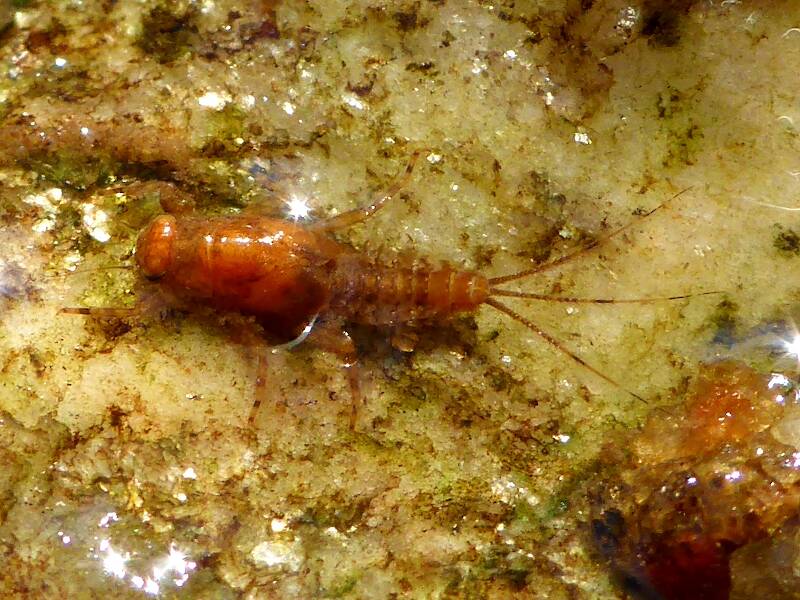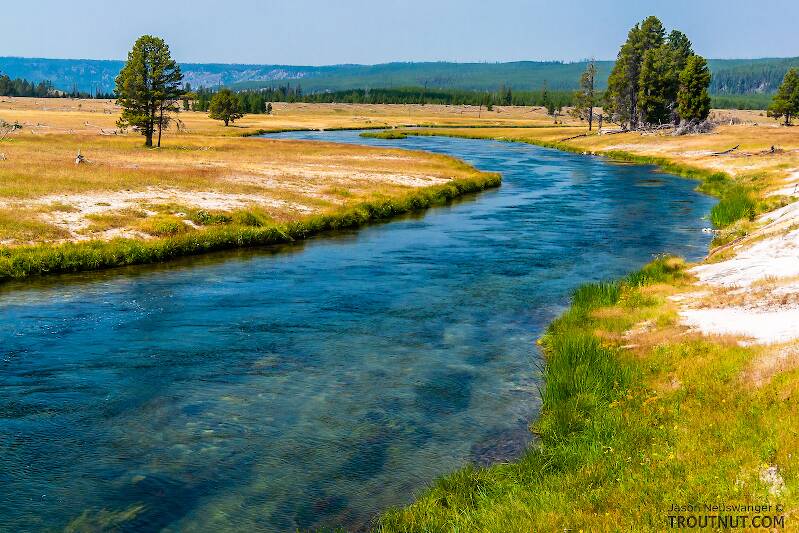
Hex Mayflies
Hexagenia limbata
The famous nocturnal Hex hatch of the Midwest (and a few other lucky locations) stirs to the surface mythically large brown trout that only touch streamers for the rest of the year.
Featured on the forum

This one seems to tentatively key to Holocentropus, although I can't make out the anal spines in Couplet 7 of the Key to Genera of Polycentropodidae Larvae nor the dark bands in Couplet 4 of the Key to Genera of Polycentropodidae Larvae, making me wonder if I went wrong somewhere in keying it out. I don't see where that could have happened, though. It might also be that it's a very immature larva and doesn't possess all the identifying characteristics in the key yet. If Holocentropus is correct, then Holocentropus flavus and Holocentropus interruptus are the two likely possibilities based on range, but I was not able to find a description of their larvae.

Troutnut is a project started in 2003 by salmonid ecologist Jason "Troutnut" Neuswanger to help anglers and
fly tyers unabashedly embrace the entomological side of the sport. Learn more about Troutnut or
support the project for an enhanced experience here.
Higherroad has attached this picture to aid in identification. The message is below.

Higherroad
Posts: 5
Posts: 5
Higherroad on May 5, 2014May 5th, 2014, 2:46 pm EDT
I hope to ID this nymph. I believe it's Maccaffertium Ithaca Light Cahill. The size was about a #16. Photographed in April in SE USA.
Entoman on May 5, 2014May 5th, 2014, 3:58 pm EDT
Hi Higherroad,
Welcome to the forum. That is a nymph from an intirely different family. It is an ephemerellid, probably in the genus Ephemerella.
Welcome to the forum. That is a nymph from an intirely different family. It is an ephemerellid, probably in the genus Ephemerella.
"It's not that I find fishing so important, it's just that I find all other endeavors of Man equally unimportant... And not nearly as much fun!" Robert Traver, Anatomy of a Fisherman
Higherroad
Posts: 5
Posts: 5
Higherroad on May 5, 2014May 5th, 2014, 4:39 pm EDT
Then a Hendrickson or Sulphur perhaps? I've never seen sulphurs on this stream though.
Wbranch on May 5, 2014May 5th, 2014, 5:14 pm EDT
It is absolutely not a Hendrickson. If you Google "Hendrickson nymph images" or "Ephemerella subvaria images" you will get a hit with tons of high quality pictures of the insect in question.
Here is a link that shows color variations among two nymphs of the same genus. The light colored nymph of dorothea does resemble your nymph picture. However I'm not a bug guy, just an avid fly fisher, so I don't differentiate very astutely about how many tails or how their sex organs look under a microscope because the trout don't really care.
http://bugguide.net/node/view/882430/bgpage
Here is a link that shows color variations among two nymphs of the same genus. The light colored nymph of dorothea does resemble your nymph picture. However I'm not a bug guy, just an avid fly fisher, so I don't differentiate very astutely about how many tails or how their sex organs look under a microscope because the trout don't really care.
http://bugguide.net/node/view/882430/bgpage
Catskill fly fisher for fifty-five years.
Entoman on May 6, 2014May 6th, 2014, 2:52 pm EDT
I think you're on the right track, Mack. Nice explanation about the synonymy.
"It's not that I find fishing so important, it's just that I find all other endeavors of Man equally unimportant... And not nearly as much fun!" Robert Traver, Anatomy of a Fisherman
Entoman on May 6, 2014May 6th, 2014, 8:47 pm EDT
Yeah, I was thinking about the possibility of the carolina form since synonymized with serrata. The prominent tubercles on the abdominal segs (particularly the ninth) and southern location got me to speculate, but the more I thought about it the more the idea seemed unlikely.
"It's not that I find fishing so important, it's just that I find all other endeavors of Man equally unimportant... And not nearly as much fun!" Robert Traver, Anatomy of a Fisherman
Entoman on May 7, 2014May 7th, 2014, 5:59 am EDT
This isn't E. dorothea dorothea though. That species doesn't have tubercles projecting beyond the posterior edges of the abdominal segments.
"It's not that I find fishing so important, it's just that I find all other endeavors of Man equally unimportant... And not nearly as much fun!" Robert Traver, Anatomy of a Fisherman
Crepuscular on May 7, 2014May 7th, 2014, 5:42 pm EDT
I love these Ephemerellid threads!
Entoman on May 7, 2014May 7th, 2014, 7:00 pm EDT
Me too!
BTW, it is a Sulfur Higherroad. If no other reason than it happens to be sulfur colored. ;) I can't imagine the dun being any other color from this nymph. The Sulfurs up in Spence's country are green (remember that one you posted a few years back that fooled me?). These ephemerellids are all over the color wheel, even in the same species.
BTW, it is a Sulfur Higherroad. If no other reason than it happens to be sulfur colored. ;) I can't imagine the dun being any other color from this nymph. The Sulfurs up in Spence's country are green (remember that one you posted a few years back that fooled me?). These ephemerellids are all over the color wheel, even in the same species.
"It's not that I find fishing so important, it's just that I find all other endeavors of Man equally unimportant... And not nearly as much fun!" Robert Traver, Anatomy of a Fisherman
Quick Reply
Related Discussions
Topic
Replies
Last Reply
0
Jun 29, 2020
by Wiflyfisher
by Wiflyfisher
1
Aug 21, 2007
by Gene
by Gene
Re: So is Ep Infrequens now known as Ep Dorothea?
In the Mayfly Species Ephemerella dorothea infrequens by Wbranch
In the Mayfly Species Ephemerella dorothea infrequens by Wbranch
20
Jul 1, 2014
by Crepuscular
by Crepuscular
Re: hook size (and chocolate duns, and old-timey mayfly family classifications)
In Eurylophella Mayfly Nymph by Warren
In Eurylophella Mayfly Nymph by Warren
10
Apr 13, 2007
by Quillgordon
by Quillgordon




